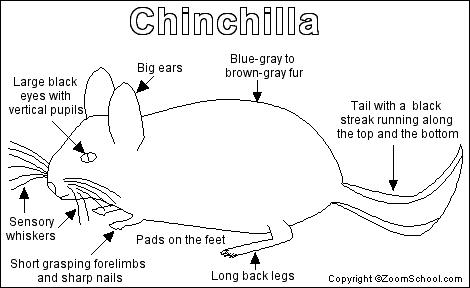
 |
| You might also like: | Ocelot Printout | Llama Printout | South American Animal Coloring/Info Pages | Alpaca Printout | Flamingo Printout | Today's featured page: The Seasons Activities |
| Rodent Printouts | EnchantedLearning.com Chinchilla | Animal Printouts Label Me! Printouts |


Few chinchillas remain in the wild (they are an endangered species), but chinchillas are common in captivity. A few chinchillas were brought to the United States in 1923; almost all the chinchillas in captivity are their descendants. Chinchillas are raised for their soft fur, which is used for clothing. Chinchillas have a life span of 15 to 20 years in captivity but only 8 to 10 years in the wild.
Diet: Chinchillas are primarily herbivores (plant-eaters); they eat tree bark, grasses, seed, fruit, grain, and herbs. Occasionally, they will eat insects. Like all rodents, their two front teeth continue to grow throughout their lives, and the chinchilla must gnaw and chew to wear these teeth down. In a sitting position, chinchillas gnaw on their food while holding the food in their hands. They do not drink much water.
Anatomy: Chinchillas range from 9 to 15 inches (23-38 cm) long plus a tail that is 3 to 6 inches (8-15 cm); they weigh from 18 to 28 ounces (510-800 g). Females are larger than males. The blue-gray to brown-gray coat is extremely soft and dense; the fur is about an inch (2.5 cm) long. The coat protects the chinchilla from the extremely cold weather of the high Andes and helps prevent water evaporation. Keen sight and acute hearing warn the chinchilla of predators.
Predators: Owls, foxes, cougars, and mountain lions prey upon chinchillas.
Reproduction: Females give birth to a litter of one to four young. Newborns have hair, teeth, and open eyes at birth. Newborns can eat plants at birth, but also drink their mother's milk for about 6 weeks.
| Search the Enchanted Learning website for: |